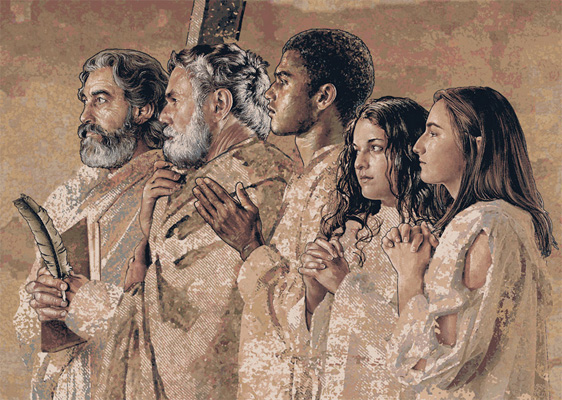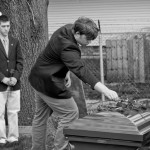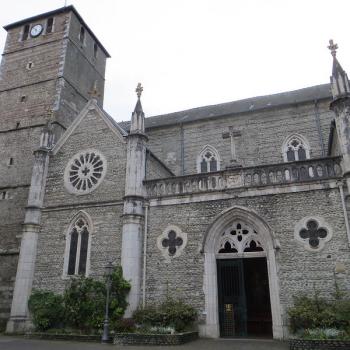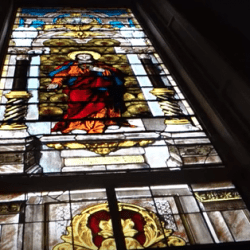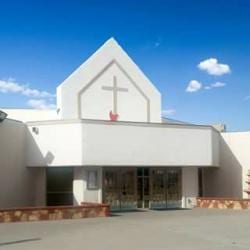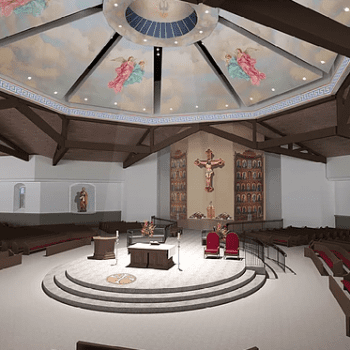I’ve preached about them in the past, but for today’s celebration of the All Saints, here’s more about the beautiful tapestries hanging in the Cathedral of Our Lady of the Angels in Los Angeles. They are the creation of artist John Nava, and they remain, I think, among the most striking and inspiring works of church art in modern times.
The tapestries created by artist John Nava for the Cathedral of Our Lady of the Angels are the largest collection hanging in a Catholic place of worship in the United States. Throughout the ages, large scale pictorial wall cycles have served as one of the most effective forms of literary expression, vividly telling the stories of the Greeks, Romans, Medieval and Renaissance periods, especially to a largely illiterate population.
Of the three tapestry groups, the most prominent is the Communion of Saints along the south and north walls of the nave. Twenty-five fresco-like tapestries depict 135 saints and blesseds from around the world, including holy men and women of North America canonized by the Church. Twelve untitled figures, including children of all ages, represent the many anonymous holy people in our midst. All the figures direct our eyes to the light of the great Cross-window above the Altar where the Eucharist is celebrated.
Nava combined digital imaging and “Old Master” methods in creating the saints for the tapestries. He constructed figures from multiple studies, combined drawn and painted elements, had costumes made when needed and even drafted family members to serve as models on occasion. He wanted the figures to look like people we know now, and did not use a highly stylized form to depict the saints. Nava’s desire is that people identify and see that “a saint could look like me.”
The Communion of Saints consists of females and males of all ages, races, occupations and vocations the world over. Saints from the Renaissance are intermingled with people from the 1st century and the 20th century.
In certain cases, particularly saints and holy people of the 19th and 20th centuries, such as Pope John XXIII and Mother Teresa, photographic evidence existed to indicate accurate appearance. In other cases, such as the 17th century saint, Ignatius Loyola, portrait paintings and death mask images were used. Cyrena Hausman, a motion pictures casting agent, worked closely with Nava and helped find many of the models chosen for the tapestries, including people who looked like known saints.
When he first was invited to be considered for the Communion of Saints tapestries, Nava recalls, “It would have fulfilled my dream at that moment to have been given one chapel and to do one small piece for that chapel.” When he learned that the work was for the entire 300-foot interior nave of the Cathedral, he realized, “It had to be something that worked in a very coherent way with the architecture.” Owing to the enormous scale and pressing time requirements of the project, he quickly realized that he would need a technological solution to realize the commission. To prepare full-scale “cartoons” in oil and by hand alone would take several years.
Nava decided to use computers in order to composite myriad separate elements that could be layered together – figures, textures and colors – and grouped into the final compositions. Working closely with Donald Farnsworth, a noted Bay Area artist, printmaker, papermaker and specialist in artistic applications of digital technology, a methodology was developed whereby a digital image could be sent directly to the loom, resulting in the woven tapestry.
The process involved research in Belgium with the weavers at the Flanders Tapestries mill and numerous woven trials. This constant testing and development of palettes and digital techniques was done simultaneously with the painting and composing of 135 figures into 25 groups for the Communion of Saints.
Nava says, “The technology made it possible. However, to get to the point where you can push the button and send the image to the loom, that was the craziness.”
The artist has been fascinated that the commission for the Cathedral has been done “completely without irony,” and that the message of the image and the message of the Church “is a message of hope, redemption and meaning.” Nava believes these are ideas that have been frequently dismissed in conventional modern art.
After the horrors of the 20th century – the World Wars, the atomic bomb and the Holocaust – humanity has routinely been seen pessimistically as “diseased and decadent,” Nava explains. The best figurative painters of our time have made great works, but they often have been of a tragic and hopeless image of humans, if not a critical or cynical one.
The Communion of Saints, however, is exactly the opposite, Nava believes. Its theme is one of hope. He would like people viewing the tapestries “to see the humanity of these figures and feel a sense of connection to themselves.”
Visit the website to see and read more. And when you’re in LA, make a point to visit the cathedral to take in this exceptional display.
It is an experience. These images never fail to leave me moved, uplifted, inspired, and humbled. They are the saints—and they are us. And their attention is transfixed forever on the altar and the Eucharist. It is, I think, a glimpse of heaven.
Happy All Saints Day.

